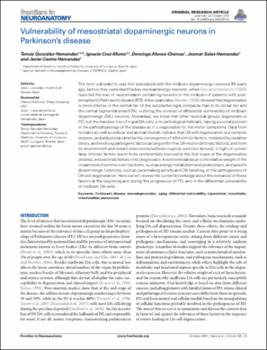Vulnerability of mesostriatal dopaminergic neurons in Parkinson's disease
Fecha
2010Resumen
The term vulnerability was first associated with the midbrain dopaminergic neurons 85 years
ago, before they were identified as monoaminergic neurons, when Foix and Nicolesco (1925)
reported the loss of neuromelanin containing neurons in the midbrain of patients with postencephalitic Parkinson’s disease (PD). A few years later, Hassler (1938) showed that degeneration
is more intense in the ventral tier of the substantia nigra compacta than in its dorsal tier and
the ventral tegmental area (VTA), outlining the concept of differential vulnerability of midbrain
dopaminergic (DA-) neurons. Nowadays, we know that other neuronal groups degenerate in
PD, but the massive loss of nigral DA-cells is its pathological hallmark, having a pivotal position
in the pathophysiology of the disease as it is responsible for the motor symptoms. Data from
humans as well as cellular and animal models indicate that DA-cell degeneration is a complex
process, probably precipitated by the convergence of different risk factors, mediated by oxidative
stress, and involving pathogenic factors arising within the DA-neuron (intrinsic factors), and from
its environment and distant interconnected brain regions (extrinsic factors). In light of current
data, intrinsic factors seem to be preferentially involved in the first steps of the degenerative
process, and extrinsic factors in its progression. A controversial issue is the relative weight of the
impairment of common cell functions, such as energy metabolism and proteostasis, and specific
dopaminergic functions, such as pacemaking activity and DA handling, in the pathogenesis of
DA-cell degeneration. Here we will review the current knowledge about the relevance of these
factors at the beginning and during the progression of PD, and in the differential vulnerability
of midbrain DA-cells.





